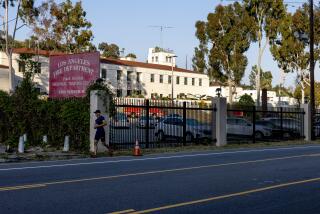County’s ‘Nerve Center’ Shows Impulse to Sum Up Uncertainty
- Share via
ANAHEIM — Radar readings showed the storm whisking away toward the desert, but outside the Orange County Storm Center late Tuesday morning, cold rain still fell in dreary sheets.
Then a new wrinkle arose: a county consultant’s forecast of a wet, wet afternoon ahead.
“Bad news,” county employee Mel Newman said as he passed the forecast along to the six men and women stationed in the county’s “nerve center” for storm operations. “There’s a band off the coast at about half an inch an hour, and it’s going to be over us for four to five hours.”
So the staff braced for a new scenario: a second hit from a two-fisted storm, possible mudslides, water-choked streets, streams transformed into churning rivers. But the feared “gully washer” never materialized, and Tuesday turned out to be just another rainy day.
Such roller-coaster events sum up the uncertainty faced by the people charged with monitoring rainfall and its effects on Orange County’s roads, streams and general welfare.
Confronted with ominous weather reports, the county’s Public Facilities and Resources Department on Monday night activated its storm center.
Two employees worked all night at a long oak table in the fluorescent-lit room in a nondescript public works building tucked away on Douglass Road near the Arrowhead Pond of Anaheim. Two more employees, both inspectors, spent the night on the road looking for problems.
County worker Bill Kirk arrived at the center at 10 p.m. Monday after a three-hour nap. He left more than 18 hours later, after he and his co-workers fielded call after call--from county staff, the California Highway Patrol, cities, and residents concerned about slow-moving storm drains.
“An average storm,” Kirk summed up.
Every report of a clogged drain required a call to an inspector to investigate firsthand. The center coordinator then dispatched workers and equipment if needed.
The pace remained slow.
Workers logged five pages of calls between 10 p.m. Monday and 2:30 p.m. Tuesday, a trickle compared to the 30 pages of reports during the torrential Dec. 6 storm.
But no one could really relax.
Rainfall data flowed into the center via five computer screens, each showing a different measure of the weather: Doppler radar images of rainfall patterns, rainfall totals, National Weather Service reports.
Newman, who monitors storms for the county, moved constantly between the computer room and the storm center across the hall. He pointed out how the heavy rain--shown as yellow and orange on radar images--was moving eastward, with rain-free areas arriving in its wake.
He scrutinized a monitor showing cloud cover over the coast at midafternoon.
“There’s light spots out there,” he said, upbeat.
The rain slowed rapidly after 4 p.m., and workers began leaving. They included supervising maintenance inspector John G. Harris, who had arrived at 10 the night before to coordinate the center, left briefly for a morning seminar and then worked all afternoon.
The center would remain open until late Tuesday evening with a skeleton crew, but the worst was over. Outside the building, glints of clear sky were visible in the west.
“It was a good day,” Harris said as he gathered his things.
“It really was a good storm fight.”
More to Read
Sign up for Essential California
The most important California stories and recommendations in your inbox every morning.
You may occasionally receive promotional content from the Los Angeles Times.













